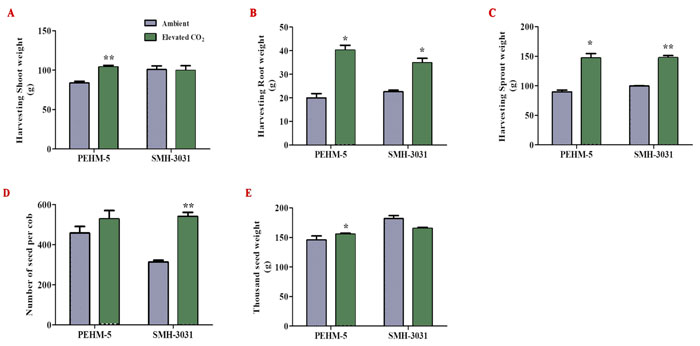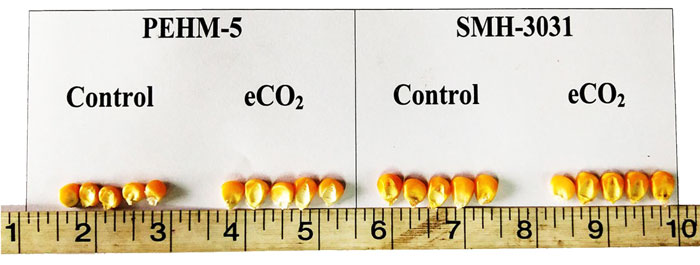| Tweet | Follow @co2science |
Paper Reviewed
Maurya, V.K., Gupta, S.K., Sharma, M., Majumder, B., Deeba, F., Pandey, N. and Pandey, V. 2020. Proteomic changes may lead to yield alteration in maize under carbon dioxide enriched condition. 3 Biotech 10: 203.
Writing as background for their work, Maurya et al. (2020) say that it is important to understand crop responses to rising atmospheric CO2 concentrations in order to make accurate predictions of future food supplies and to be able to adapt and utilize crop varieties so as to "exploit" this valuable resource. And thus they go on to explain how they conducted an experiment to evaluate the growth, physiology and yield of two maize (Zea mays) varieties under ambient (398 ppm) and elevated (530 ppm) CO2 concentrations.
The work was conducted at a Free-air CO2 Enrichment (FACE) facility at CSIR-National Botanical Research Institute in Lucknow, Uttar Pradesh, India. Both cultivars studied are common to Indian farming. Variety PEHM-5 is described as an early maturing hybrid tolerant to waterlogging, whereas variety SMH-3031 is a late variety hybrid more suitable to drought that is higher yielding than PEHM-5. Carbon dioxide enrichment (132 ppm above an ambient value of 398 ppm) was supplied for only 8 hours per day (0900 to 1700), which meager one-third-of-the-day enrichment suggests the authors' findings are likely conservative, with the maize plants being unable to take full advantage of the growth-enhancing benefits of elevated CO2.
And what did their work reveal?
As shown in Figure 1, CO2 enrichment for a mere 8 hours per day was still sufficient to enhance multiple yield attributes of the two cultivars. Specifically, elevated CO2 stimulated root weight, shoot weight, sprout weight, aboveground biomass, total biomass, number of sees per cob, thousand seed weight and harvest index by 50%, 29%, 39%, 34%, 36%, 13%, 6% and 7%, respectively, in PEHM-5 and by 35%, 5%, 32%, 21%, 23%, 42%, -10% and 14% in SMH-3031. Additionally, seed size was positively impacted in PEHM-5 (15% increase in seed length and 5% increase in seed width), whereas it was unchanged in SMH-3031 (see Figure 2).
Interestingly, despite the growth improvements noted above, plant photosynthesis was unaltered by CO2 enrichment. However, both varieties experienced traditional declines in transpiration (46% for PEHM-5 and 27% for SMH-3031) and increases in plant water use efficiency (33% for PEHM-5 and 78% for SMH-3031) in the elevated CO2 treatment.
Maurya et al. also report that PEHM-5 "had better seed quality [among the two cultivars] in terms of significantly improved total soluble sugar and starch content of grains." Additional analyses showed a "reduced level of antioxidant (total and reduced glutathione) and antioxidative enzymes in both varieties," which they say "may reflect reduced photorespiration and decreased reactive oxygen species level due to elevated CO2." It may also indicate a reduction in certain stresses during the growing season that affected ambient CO2 grown plants more than those grown under elevated CO2.
The above findings should help in making accurate predictions of future food supplies, an objective of the authors' research. And the significance of their findings is the sheer magnitude of growth response to CO2 enrichment witnessed by the two cultivars. Climate alarmists have long claimed that C4 plants like maize are unresponsive to CO2 enrichment, yet more and more research -- like that observed here -- is falsifying that narrative, showing that yields of many C4 crops will likely experience significant gains in the future.

Figure 1. Yield attributes (mean ± standard error) of two Zea mays cultivars (PEHM-5 and SMH-3031) under ambient (398 ppm) or elevated (530 ppm) CO2 conditions. a Shoot weight; b root weight; c sprout weight; d number of seed per cob; e thousand seed weight. Significant results of student's t test are marked with asterisks (*p < 0.05, **p < 0.01 and ***p < 0.001). Source: Maurya et al. (2020).

Figure 2. Comparison of kernels from two Zea mays cultivars (PEHM-5 and SMH-3031), illustrating the impact of elevated CO2 on seed size. Source: Maurya et al. (2020).




